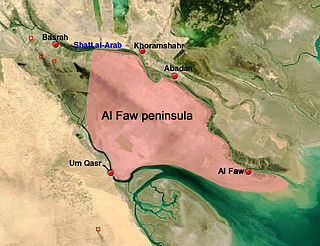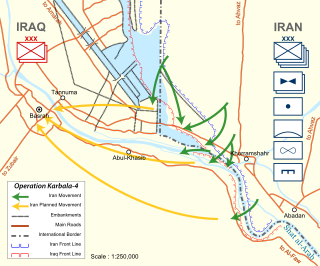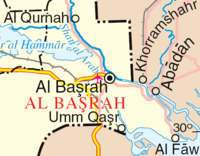
The Iran–Iraq War, also known as the First Gulf War, was an armed conflict between Iran and Iraq that lasted from September 1980 to August 1988. Active hostilities began with the Iraqi invasion of Iran and lasted for eight years, until the acceptance of United Nations Security Council Resolution 598 by both sides. Iraq's primary rationale for the attack against Iran cited the need to prevent Ruhollah Khomeini—who had spearheaded the Iranian Revolution in 1979—from exporting the new Iranian ideology to Iraq. There were also fears among the Iraqi leadership of Saddam Hussein that Iran, a theocratic state with a population predominantly composed of Shia Muslims, would exploit sectarian tensions in Iraq by rallying Iraq's Shia majority against the Baʽathist government, which was officially secular and dominated by Sunni Muslims. Iraq also wished to replace Iran as the power player in the Persian Gulf, which was not seen as an achievable objective prior to the Islamic Revolution because of Pahlavi Iran's economic and military superiority as well as its close relationships with the United States and Israel.

The Al-Faw peninsula is a peninsula in the Persian Gulf, located in the extreme southeast of Iraq. The marshy peninsula is 20 km (12 mi) southeast of Iraq's third largest city, Basra, and is part of a delta for the Shatt al-Arab river, formed by the confluence of the major Euphrates and Tigris rivers. The al-Faw peninsula borders Iran to the northeast, with the cities of Abadan and Khorramshahr on the opposite side of the Shatt al-Arab, and Kuwait to the southwest, opposite from Bubiyan Island and Warbah Island, near the Iraqi city of Umm Qasr.

The Islamic Revolutionary Guard Corps, also called Sepah or Pasdaran, is a multi-service primary branch of the Iranian Armed Forces. It was officially established by Ruhollah Khomeini as a military branch in May 1979, in the aftermath of the Iranian Revolution. Whereas the Iranian Army protects the country's sovereignty in a traditional capacity, the IRGC's constitutional mandate is to ensure the integrity of the Islamic Republic. Most interpretations of this mandate assert that it entrusts the IRGC with preventing foreign interference in Iran, thwarting coups by the traditional military, and crushing "deviant movements" that harm the ideological legacy of the Islamic Revolution. Currently, the IRGC is designated as a terrorist organization by Bahrain, Saudi Arabia, Sweden and the United States.

Operation Ramadan was an Iranian offensive in the Iran–Iraq War that consisted of three separate attacks that lasted for 6 weeks. It was launched by Iran on 13 July 1982 near Basra and featured the use of human wave attacks in the largest land battle since World War II. The engagement was a part of the overall stalemate.

The First Battle of al-Faw was a battle of the Iran–Iraq War, fought on the al-Faw peninsula between 10 February and 10 March 1986. The Iranian operation is considered to be one of Iran's greatest achievements in the Iran–Iraq War. The Iranians were able to capture the al-Faw peninsula, cutting off Iraqi access to the Persian Gulf in the process; this in turn hardened Iraqi attitudes to prosecute the war. The Faw peninsula was later recaptured by Iraqi forces near the end of the war.

The Second Battle of al-Faw (also known as the Operation Ramadan Mubarak (Blessed Ramadan), fought on 17 April 1988, was a major battle of the Iran–Iraq War. After their defeat at the First Battle of al-Faw two years earlier, the newly restructured Iraqi Army conducted a major operation to clear the Iranians out of the peninsula.

Operation Fath-ol-Mobin was a major Iranian military operation conducted during the Iran–Iraq War, in March 1982. The operation was led by Lt. General Ali Sayad Shirazi, and was conducted in four phases.
The Battle of the Marshes was a part of the Iran–Iraq War.
Operation Karbala-6 was an Iranian operation during the Iran–Iraq War to prevent Iraq from rapidly transferring units to its defense lines at Basra after Iran had launched Operation Karbala-5 to capture the city of Basra.
Operation Dawn 4 was an Iranian operation of the Iran–Iraq War launched in October 1983. At the end of the operation Iran had captured a small amount of territory from the Iraqis.
Operation Dawn-1 was an Iranian offensive in the Iran–Iraq War. On April 10, 1983, Iran struck Ayn Al-Qaws with the immediate objective of Al-Fakkah Field to capture the Baghdad-Basra Highway. The operation was fought mostly by Pasdaran forces and was one of the three costly human wave offensives of 1983, the Iranians failed to defeat the Iraqis.
Operation Before the Dawn was an offensive operation launched by Iran during the Iran-Iraq War in 1983 around the Amarah area 200 kilometers southeast of Baghdad. It was carried out under the command of the Islamic Revolutionary Guard Corps along with the support of the regular army, during the operation, Iran suffered heavy casualties due to weak air support and heavy Iraqi artillery fire and aerial bombing.

Operation Badr was an Iranian operation conducted during the Iran–Iraq War against the forces of Ba'athist Iraq. The Iranians launched their offensive on March 11 and succeeded in capturing a part of the Basra-Amarah-Baghdad highway. The following Iraqi counterattack, however, forced the Iranians out in a continual war of endless stalemate.

Operation Karbala-4 was an Iranian offensive in the Iran–Iraq War on the southern front. The operation was launched after the failure of Operation Karbala-2 and Operation Karbala-3 to move the Iraqi lines in an effort to capture Iraqi territory.

Operation Kheibar was an Iranian offensive in the Iran–Iraq War. It was part of the Battle of the Marshes.
Operation Dawn 6 was a military operation conducted by the forces of the Islamic Republic of Iran against the armed forces of Saddam Hussein's Iraq. It lasted from 22 to 24 February 1984 and, along with Operation Dawn 5, it was part of a larger strategic operation to secure part of the Baghdad–Basra highway, thus cutting two of Iraq's most important cities from each other, and threatening the network supplying the Iraqi military on the front line. Operation Before the Dawn succeeded in capturing some high ground 15 miles from the highway, and Operation Dawn 6 was designed to exploit the Iranians' capture with a breakthrough towards the highway. However, the operation met an Iraqi defence which stood up to every attack, and the Iranians called off the attack after only two days. This led to Operation Kheibar, the re-focus of the Iranian offensive towards Basra directly.

The First Battle of Khorramshahr was a major battle in the Iran–Iraq War, beginning shortly after the Iraqi invasion of Iran in September 1980. Amidst the gruelling urban warfare in and around the city, Khorramshahr came to be referred to by the Iranians as Khuninshahr, as both sides had suffered heavy casualties in combat. It was the single largest urban battle of the Iran–Iraq war.

Operation Tawakalna ala Allah were a series of five highly successful Iraqi offensives launched in April 1988 and lasting until July 1988. Iraq had originally only intended to retake the al-Faw peninsula it had lost to Iran, but following the battles' extraordinary success due to the complete collapse of the Iranian troops present, the Iraqi command decided to expand the battle into a larger offensive campaign, ultimately leading to the expulsion of all Iranian forces present within Iraq and subsequent renewed invasion of Iran.

The siege of Basra, code-named Operation Karbala-5 or The Great Harvest, was an offensive operation carried out by Iran in an effort to capture the Iraqi port city of Basra in early 1987. This battle, known for its extensive casualties and ferocious conditions, was the biggest battle of the war and proved to be the last major Iranian offensive. The Iranians failed to reach their objective.
Operation Karbala 8 was an operation which was commenced by Iran on 7 April 1987 with the --Islamic-- code of "Ya Saheb al-Zaman".












